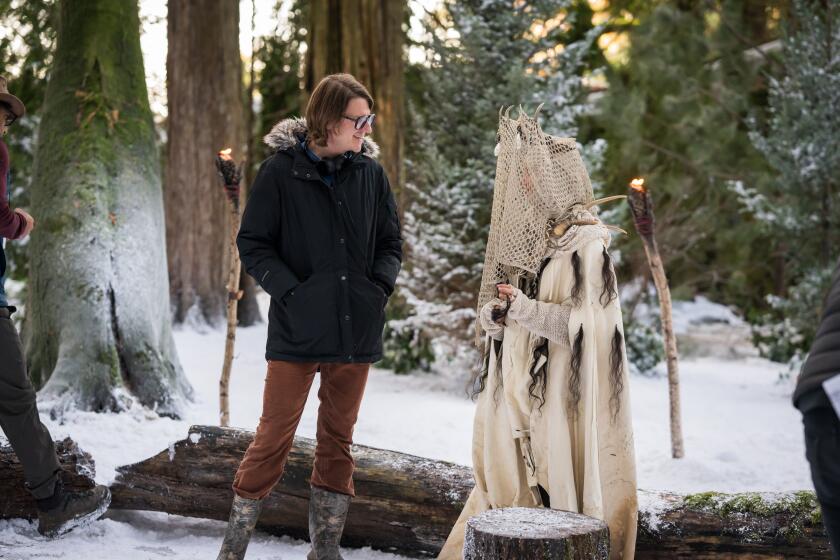Review: Tony-winner Jefferson Mays, a virtuoso working solo, brings ‘A Christmas Carol’ back from the dead
- Share via
Charles Dickens has become so yawningly familiar through adaptations that it can be jolting to experience his storytelling genius directly from the fictional works themselves.
No literary property has suffered more from secondary overexposure than his 1843 novella, “A Christmas Carol,” which has become a staple of holiday programming at theaters across the country. I once worked at a theater that depended on Dickens to replenish the coffers at the end of the year. (My complimentary tickets were liberally distributed among colleagues with children.) As a critic, I may have spat out a “Bah humbug!” to an editor wondering if I’d consider reviewing a supposedly fresh take on the show.
No one, however, had to talk me into seeing this new production of “A Christmas Carol” at the Geffen Playhouse. All it took was the name Jefferson Mays, the Tony-winning virtuoso, who is single-handedly populating the story through the summoning powers of his acting. For true theater lovers, there can be no better gift this season.
Mays, who won a Tony for his soloist tour de force in Doug Wright’s “I Am My Own Wife,” is a performer who can unleash multitudes. He proved it more recently in “A Gentleman’s Guide to Love & Murder,” playing the gallery of aristocratic victims, one more deliciously eccentric than the next.
The staging of this “Christmas Carol” offers a fully integrated theatrical vision. The ingenious director Michael Arden (Deaf West Theatre’s brilliant “Spring Awakening,” the Tony-winning revival of “Once on This Island”) extends all the care one might lavish on a precious antique music box.
Mays is the rare gem that gives this production its mesmerizing glint. The snooty, snarling, subordinate voices of Victorian England come naturally to him. He shares the gift of his author, an avid theatergoer who wanted early on to be an actor, of knowing how to balance the exaggeration of a cartoonist with the precision of a jeweler.
Fog continually rolls in on Dane Laffrey’s darkened set. The foreboding atmosphere is artfully composed by the design team, setting the stage for a ghost story that looks as though it could conceivably conjure actual spirits to the theater.
The lighting by Ben Stanton flickers, flashes and fades to black. Sudden eruptions of noise (orchestrated by sound designer Joshua D. Reid) jangle nerves onstage and off. (No that wasn’t me slouching fearfully in my seat — it was another journalist from a less reputable publication.)
My only quibble with the production is the way the adaptation by Mays, Susan Lyons and Arden has been abridged. Should your attention be distracted by harrowing screams or the clanging of invisible chains, you might have to scramble to find your narrative footing. The distillation of this intermission-less show is appreciated, but perhaps a touch more exposition would better illuminate every creaking twist in Ebenezer Scrooge’s path.
The clarity of Mays’ characterizations, however, is never in doubt. If he locates the stations of his characters in their bent or rigid postures, he finds their souls in the cadences of their speech.
His Scrooge only penuriously emits words; his replies are begrudgingly uttered to instantly nip conversation in the bud. His clerk Bob Cratchit, by contrast, has a softer flow. His tone may be anxiously apologetic, but there’s a hopeful generosity to his greeting.
Mays seems to be momentarily possessed by each of the terrifying ghosts who visit Scrooge. When his voice slides into howling it seems in danger of exploding. Even his hair appears to be electrically charged with poltergeist activity. He looks during the visitations as if he could go up in smoke.
But this “Christmas Carol” is genuinely scary because, following the lead of the novella, so much is left to our imaginations. Only near the end does Arden supply us with an occult figure. Throughout he takes a more Henry Jamesian approach, connecting the supernatural to the psychological.
Mays is an ideal conduit for Dickens’ authorial voice. He relishes the sly observational humor as well as the horror. The poverty of the world is what really freezes the blood in “A Christmas Carol,” and Mays wrings from each word in the narrative the sorrow of economic injustice.
But his performance, more than any other I’ve seen, makes Scrooge’s spiritual conversion seem plausible. The goodness of Tiny Tim, nestled in the love of his struggling but contented family, is what haunts this miser as he confronts the reality of his own mortality.
Tombstones figure prominently at the end of “A Christmas Carol,” but they signify a rebirth — for Scrooge and for this old holiday chestnut.
♦ ♦ ♦ ♦ ♦ ♦ ♦ ♦ ♦ ♦ ♦
‘Charles Dickens’ A Christmas Carol’
Where: Geffen Playhouse, Gil Cates Theater, 10886 Le Conte Avenue, Westwood
When: 8 p.m. Tuesdays-Fridays, 3 and 8 p.m. Saturdays, 2 and 7 p.m. Sundays; ends Dec. 9
Tickets: $30 $120 (subject to change)
Information: (310) 208-5454 or www.geffenplayhouse.org
Running time: 1 hour, 35 minutes
Follow me @charlesmcnulty
More to Read
The biggest entertainment stories
Get our big stories about Hollywood, film, television, music, arts, culture and more right in your inbox as soon as they publish.
You may occasionally receive promotional content from the Los Angeles Times.











